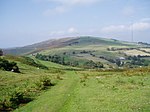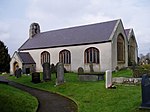Penycloddiau

Penycloddiau is a hill in Flintshire, Wales, and one of five Marilyns in the Clwydian Range. The hill, like Foel Fenlli and Moel Arthur to the south, has an Iron Age hillfort at its summit. It covers 26 hectares (64 acres) making it one of the largest hillforts in Wales. In 2017, excavations by the Clywdian Range Archaeology Group (CRAG) unearthed a significant number of 4,000-year-old stone tools from the Bronze Age, the discovery indicates human activity occurred much earlier than first thought in the area.Penycloddiau is crossed by the Offa's Dyke Path and the Clwydian Way, two long distance footpaths that traverse the hills in this area. A free car park exists at the bwlch between Penycloddiau and Moel Arthur, where two footpaths lead to the summit.
Excerpt from the Wikipedia article Penycloddiau (License: CC BY-SA 3.0, Authors, Images).Penycloddiau
Byway Open to All Traffic, St Asaph Llandyrnog
Geographical coordinates (GPS) Address External links Nearby Places Show on map
Geographical coordinates (GPS)
| Latitude | Longitude |
|---|---|
| N 53.20008 ° | E -3.30834 ° |
Address
Penycloddiau Hill Fort
Byway Open to All Traffic
LL16 4LY St Asaph, Llandyrnog
Wales, United Kingdom
Open on Google Maps








